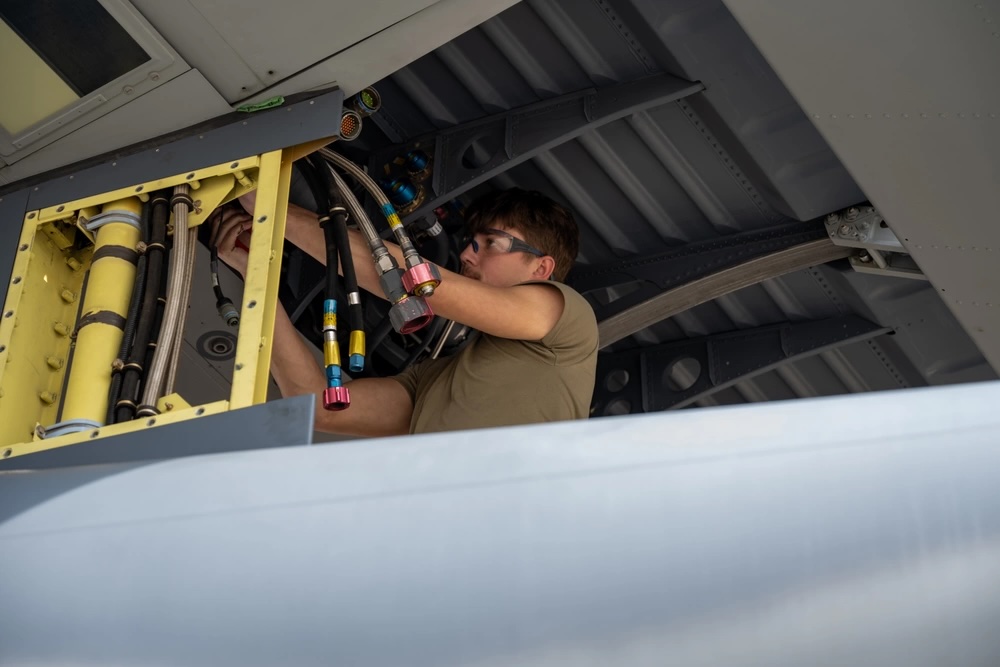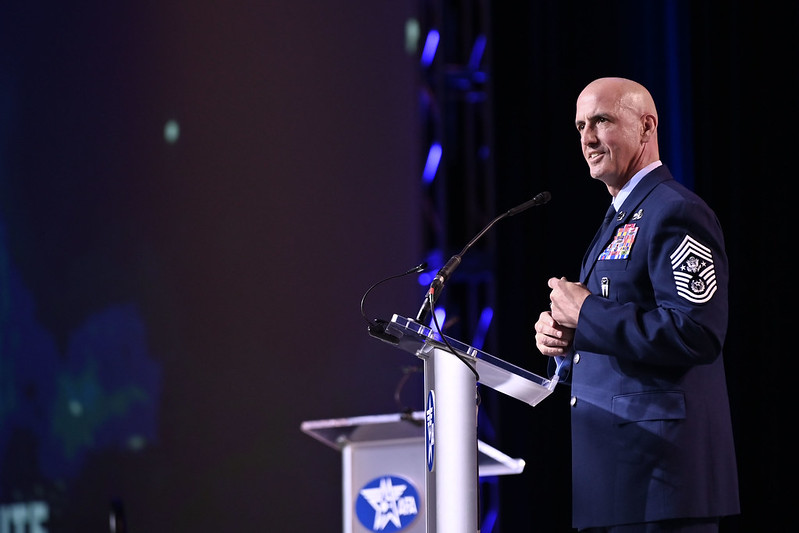As the Air Force leans into the idea of mission-ready Airmen, Chief Master Sergeant of the Air Force David Flosi floated the idea of consolidating some of the branch’s more than 130 Air Force Specialty Codes while increasing training opportunities for Airmen to gain skills working in smaller teams.
Many Air Force enlisted job specialties involve similar work, Flosi told reporters at AFA’s Air, Space & Cyber Conference. He cited a recent analysis by Air Force headquarters, which identified 54 aircraft maintenance AFSCs, and noted that of the many tasks they train for, only 20 percent of them make up the vast majority of the work they do—80 percent, in fact.
Air Force headquarters sees “an opportunity to drastically reduce the total amount of AFSCs and build really good aircraft maintainers on that first 20 percent, which will provide us more agility on the flight line,” the chief said. “We’ll have more people that are qualified on the tasks that are most frequently done, and then bolt-on capability capacity.”
The Air Force has not made a decision to cut or combine similar AFSCs, but officials are analyzing career fields to see if reducing the number of specialties could make sense. Leaders say Airmen must be ready to handle multiple tasks when operating in an agile combat employment scenario, which involves working in smaller, disaggregated groups on a battlefield where enemy missiles are a constant threat.
“We’ll be contested in the air, on the ground, in the information environment. Supply chains are far more difficult in the INDOPACOM theater,” Flosi said. “So we need to put the smallest number of Airmen into harm’s way and achieve the maximum capacity out of each one of them.”
Each AFSC has its own pipeline and career path, which is great for technical specialization but not necessarily helpful in a contested environment, he explained. The Air Force plans to analyze the similarities between specialties within a career field such as aircraft maintenance, as well as the similarities between specialties in different career fields. Combining pipelines would eliminate stovepipes and increase flexibility, Flosi said.
“I’d be able to take this Airman that’s now qualified on more than one type of job, and I could employ her to do both, potentially, in an operational environment,” he explained. “So I’ve just now reduced our burden by 50 percent because we’re getting more capacity out of her.”
Many Airmen and units are already doing this. In his keynote address, Flosi pointed out Senior Airman Marlene Guerrero, a fuels technician with the 353rd Special Operations Wing who is also trained on hydraulics and is an assistant dedicated crew chief. Guerrero put those skills to work when she joined a repair team to fix a forward aircraft with a hydraulic problem. That’s not the kind of thing one would see at a large air base in the Middle East 10 or 15 years ago, Flosi said.
“You wouldn’t find somebody that was a crew chief and a fuels technician—ever,” he told reporters. “And so the fact that we’re not only training to that standard, but then employing that Airman with those multiple capabilities is game-changing, and that’s the type of thing we need to be able to do in a contested environment.”

Another example Flosi offered was the 1st Special Operations Aircraft Maintenance Squadron, which developed a 12-member team capable of supporting multiple forward-deployed aircraft “for days on end,” Flosi said. The Airmen not only launched and recovered aircraft, but also supplied their own food, ammunition, water, security, and communications, a task that conventional planning would have required 40 or 50 people, he added. Cross-training Airmen made the smaller team possible.
“Even the air crew that lands can be qualified on a lot of those tasks to help with the mission while they’re on the ground,” Flosi said.
The Air Force is working on an “institutional backbone” to build out that kind of capability across the service, the chief said.
Flosi said Airmen should not see this effort to combine specialties and promote mission-ready skillsets as an attempt to do more with less. “We’re not trying to, like, squeeze 10 people’s worth of work into five people,” he said. “We want to have the capability for an Airman to do as much as they have capacity for.”
Judging that capacity is part of each commander’s risk calculations.
The Air Force will hold a two-day conference with wing commanders and command chiefs from across the service later this week. One of the major topics will be “taking risk in a smart and disciplined way,” Flosi said.
“We’re going to be talking more about that: how to ensure our commanders know we’ve got their back and we want them to execute and take risk when necessary, [but] to not overburden any particular Airmen,” he said.
